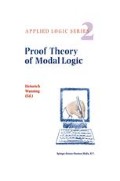Abstract
The present paper explores applications of Display Logic as defined in [1] to modal logic. Acquaintance with that paper is presupposed, although we will give all necessary definitions. Display Logic is a rather elegant proof-theoretic system that was developed to explore in depth the possibility of total Gentzenization of various propositional logics. By Gentzenization I understand the strategy to replace connectives by structures. Gentzenization is something of an ingenious optical trick because it uses a single symbol to mean different things depending on the place it occupies in the sequent. In the original Gentzen system it was the comma that had to be interpreted as and when to the left of the turnstile and as or when to the right. The interpretation of the structures oscillates between two logical symbols depending on whether it is in the antecedent or in the consequent. This is why we call symbols like comma Gentzen toggles. These two symbols between which this toggle switches are the Gentzen duals of each other. So, and and or are Gentzen duals. The strength of Display logic lies in a rather general cut-elimination theorem. In [10] and [9], Heinrich Wansing has refined these methods for modal logics; he showed that contrary to Belnap’s own Gentzenization of modal operators as binary structure operators, a unary one is more appropriate (not only from an esthetical point of view) and makes perfect sense semantically as well. The Gentzen dual of the modal operator □ is actually not — as one might expect — the. possibility operator ◇, but the backward looking possibility operator, denoted here by ◇. (To be consistent with that we write □ instead of □ and ◇ instead of ◇.) The corresponding toggle is denoted by •. The reason why this is so natural lies in the fact that it is the exact Display or Gentzen dual, for we have that the sequent •B ⊢ A and the sequent B ⊢ • A are equivalent if • is read as if in the antecedent and if it is read as 0 if in the consequent. Wansing uses this fact to display various modal and tense logics à la Belnap by providing some formula introduction rules and basic structural rules for K and Kt and then Gentzenizing the additional axioms. The benefit lies not only in the homogeneity with which all these systems are now handled and the rather clear intuitive background. The benefit lies in the possibility to use the general cut-elimination theorem of [1].
Access this chapter
Tax calculation will be finalised at checkout
Purchases are for personal use only
Preview
Unable to display preview. Download preview PDF.
References
N. D. Jr. Belnap. Display logic. Journal of Philosophical Logic, 11, 375–417, 1982.
K. Fine. Some connections between elementary and modal logic. In: S. Kanger, (ed), Proceedings of the Third Scandinavian Logic Symposium, pp. 15–31. North-Holland, Amsterdam, 1975.
M. Kracht. Internal Definability and Completeness in Modal Logic. PhD thesis, FU Berlin, 1991.
M. Kracht. How completeness and correspondence theory got married. In: M. de Rijke, (ed.), Diamonds and Defaults, pp. 175–214. Kluwer, Dordrecht, 1993.
M. Kracht. Highway to the danger zone. Journal of Logic and Computation, 5, 93–109, 1995.
M. Kracht. Tools and Techniques in Modal Logic. Freie Universität Berlin, 1995.
H. Sahlqvist. First and second order semantics for modal logic. In: S. Kanger, (ed.), Proceedings of the Third Scandinavian Logic Symposium, pp. 15–31. North-Holland, Amsterdam, 1975.
J. van Benthem. Correspondence theory. In: D. M. Gabbay, F. Guenthner, (eds), Handbook of Philosophical Logic, Vol. 2, pp. 167–247. Reidel, Dordrecht, 1984.
H. Wansing. A full circle theorem for simple tense logic. In: M. de Rijke, (ed.), Recent Advances in Modal and Intensional Logic. 1994. To appear.
H. Wansing. Sequent calculi for normal modal propositional logics. Journal of Logic and Computation, 4, 125–142, 1994.
H. Wansing. Strong cut-elimination in Display Logic. Institute of Logic and Philosophy of Science, University of Leipzig, 1994.
Author information
Authors and Affiliations
Editor information
Editors and Affiliations
Rights and permissions
Copyright information
© 1996 Springer Science+Business Media Dordrecht
About this chapter
Cite this chapter
Kracht, M. (1996). Power and Weakness of the Modal Display Calculus. In: Wansing, H. (eds) Proof Theory of Modal Logic. Applied Logic Series, vol 2. Springer, Dordrecht. https://doi.org/10.1007/978-94-017-2798-3_7
Download citation
DOI: https://doi.org/10.1007/978-94-017-2798-3_7
Publisher Name: Springer, Dordrecht
Print ISBN: 978-90-481-4720-5
Online ISBN: 978-94-017-2798-3
eBook Packages: Springer Book Archive

